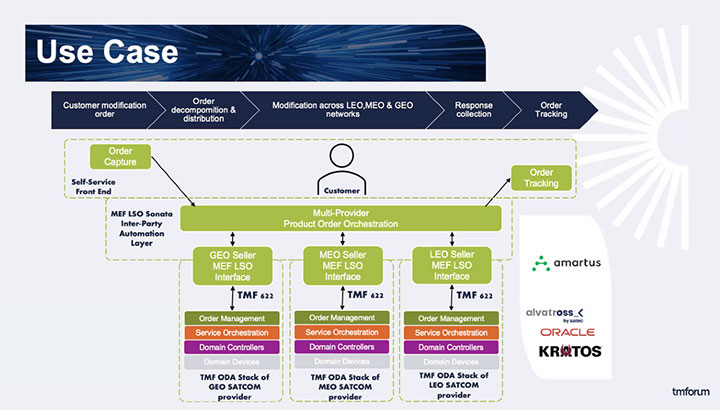
A group of seven companies, including satellite operators SES, OneWeb and Airbus, recently demonstrated multi-orbit interoperability, showing how telcos and customers could interact with satellite connectivity providers in a more seamless way for satcom services.
The demonstration took place at Digital Transformation World 2023 (DTW23) Ignite, the TM Forum event that showcases Catalyst innovations—proofs of concept that address challenges in the global telecom ecosystem. TM Forum is a global alliance and standards body for over 800 telecommunications and technology companies, including the world’s top 10 communication service providers.
The “Open SATCOM Management” Catalyst was championed by SES, OneWeb, Airbus and Amartus with support from Alvatross, Oracle and Kratos. It was the first-ever satellite communications demonstration in front of the TM Forum community.
The companies showed how using open APIs (application programming interfaces) and standards, they could deliver a seamless end-to-end satcom service across GEO, MEO and LEO providers that telcos could order, activate and manage in near real-time.
Dr. Amina Boubendir, Head of Research and Standardization at Airbus said the Catalyst showcased how TM Forum’s APIs and other standards can be reused and adapted for satellite communications. “Interoperability is all about interfacing different subsystems and making sure they work together properly.”
For a satellite industry that’s been built mostly around closed, proprietary solutions with limited interoperability, the collaboration showed how different products from commercial satellite operators and vendors can be integrated to offer flexible end-to-end satcom as a more standardized service through a customer portal.
David Villegas, Senior Manager for Digital Architecture for SES, said, “We were able to say ‘We can talk with you in your same language that you request terrestrial connectivity. With MEF and APIs, now you can request satellite connectivity the same way. You don’t have to do anything different to connect with us.’”
Making Multi-Orbit Look More Like Mobile
Satcom is often the only connectivity option in many use cases or parts of the world. However, a single orbit or regional satcom provider may be unable to offer an end-to-end service with the necessary capacity, coverage area or latency.
LEO, MEO and GEO interoperability allows satcom providers to offer highly available, manageable value-added services that could be bundled or adjusted on demand for a broader market of customers and verticals.
Boubendir of Airbus compared the need for seamless satcom to today’s mobile networks that keep users connected through interoperability and roaming, which the satellite industry is unable to do currently.
“In the end, customers just want connectivity to meet their needs. Our job is to make it transparent and to hide the complexity. Whether it’s multi-vendor or multi-technology, we want to make sure we can support connectivity needs without fail, whether that’s ‘five 9’s’ or mission critical availability.”
Connecting and Orchestrating the Pieces
The Catalyst demonstration showed how different products from commercial satellite operators and vendors can be integrated to meet a need, in this case, to deliver a mission critical service.
 A slide from the Open Satcom Management presentation at the DTW23 TM Forum Open Innovation Catalyst illustrating a use case scenario, presented by project champions SES, Airbus, OneWeb. (Source: SES)
A slide from the Open Satcom Management presentation at the DTW23 TM Forum Open Innovation Catalyst illustrating a use case scenario, presented by project champions SES, Airbus, OneWeb. (Source: SES)
The demo used SES for MEO and GEO service and OneWeb for LEO service to deliver connectivity over the three orbits. Airbus played the role of reseller/partner to deliver the service to a mission critical client in a region where the commercial services were available.
The Catalyst showed the end-to-end automation of a satcom order that a customer could place or modify directly from a self-service interface or portal. The order activated a workflow that was then automatically decomposed and orchestrated through the stack all the way down to activation.
Villegas of SES explained that it took the Catalyst team only 90 days to establish interoperability for the demonstration using TM Forum APIs and a digital framework to interconnect different vendor solutions that didn’t work together previously.
TM Forum APIs enable services to be managed end-to-end in multi-vendor environments. The partners used the APIs to connect the various applications and components including everything from the customer self-service front-end through the product, service and resource design, ordering, orchestration, and activation.
Villegas explained that the interfaces between the layers of the digital architecture are like Lego blocks.
“The back office would be a block of Lego and the interfaces in between would connect them. All of that is defined. We only needed to define a model for the satellite product.”
MEF’s widely used Carrier Ethernet standards were also used in the Catalyst to specify the transport layer. Boubendir said MEF compliance for IP connectivity assures the link can be made from the TM Forum assets to the network management implementation in largescale IP transport networks.
The Outcome
By standardizing and simplifying IT processes, the carriers and their applications can communicate with each other and up the stack closer to the customer.
Villegas said that TM Forum was a platform to show that it’s possible to have flexible satellite connectivity products that allow customers to “interact with us anytime anywhere, like they do in the rest of their lives with providers.”
“We’ve shown we’re not that far from a telecommunications company, and that it’s just connectivity. As satellite operators we’re showing that we’re up to speed on digital transformation, and that we can offer self-service for flexible connectivity, and that we can accelerate by adopting off-the-shelf solutions.”
He said the key message to the satcom industry is that it needs to evolve and be more open and accessible, and that standardization is possible and beneficial.
Anthony Semiao, Chief Solutions Architect at Kratos, explained that a goal of the Catalyst was to develop a more integrated satellite-terrestrial ecosystem. “You can’t do that with proprietary interfaces, you need open standards which make it easier for people to integrate,” he said. “We want to encourage that ecosystem and that openness, because the satellite industry today is not that way.”
With the market for satcom services expected to be worth around $74 billion by 2031, the Catalyst solution is targeted at an industry ecosystem that includes operators, distribution partners and OSS/BSS vendors.
“We’re leveraging the work that all these TM Forum members have been contributing for years,” Villegas added. “They’ve been defining their processes and their support systems, and how they interact with one another.”
For its groundbreaking work, the Catalyst team was named Finalist for “Outstanding Use of TM Forum Assets,” in the Innovation Catalyst Awards.
Success and Next Steps
As the first satcom demo at TM Forum, Boubendir said the highlight was putting together a consortium of satellite players and non-satellite players from TM Forum to show how all the concepts and tools could be applied to this new scope.
“I think we managed to show the TM Forum community that there’s another community willing to join and take the digitalization and automation journey in the proper way: to reuse and not reinvent standards … and that we’d like to build on this.”
As a result of the collaboration, Boubendir said that the Catalyst partners are reusing the outcomes internally and are planning to advance a “Phase II” demonstration featuring a mobile partner.
She emphasized that every player in the ecosystem can find advantages in opening their systems to be interoperable. If vendors comply with standards, “then when we buy their solution, we can make sure it’s interoperable and can easily integrate it. It’s a win-win.”
Villegas of SES added that for satellite operators who both compete and cooperate, “We showed we can indeed come together and get a result that we all believe is good for the industry, and that will be a game-changer.”
The main participants in the 2023 Catalyst program signaled their intention to continue collaborating with TM Forum and teased another satcom demo at next year’s TM Forum Ignite conference.
Explore More:
Podcast: Satellite Industry Shift, Demand Drivers and the $60B Market Opportunity
GSMA’s Open Gateway Initiative Is a Must-Watch for the Satellite Industry
Is Cloud Native Make of Break for Satellite 5G?
University Spotlight: A Test Environment for the Internet of Space Things
